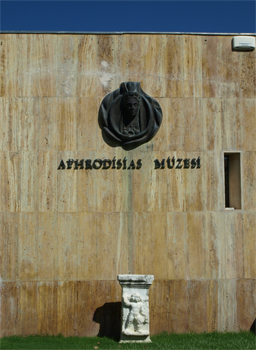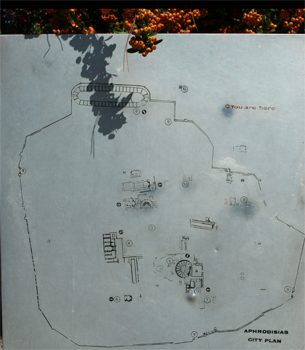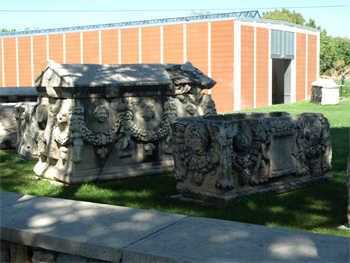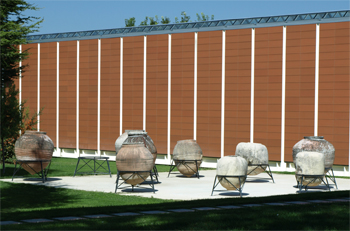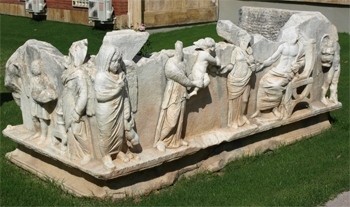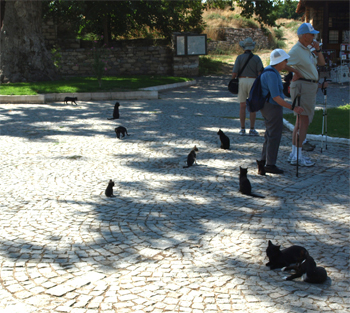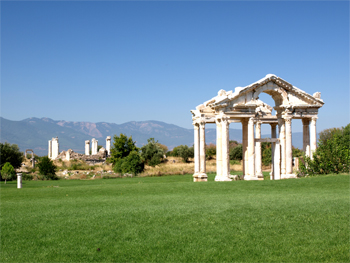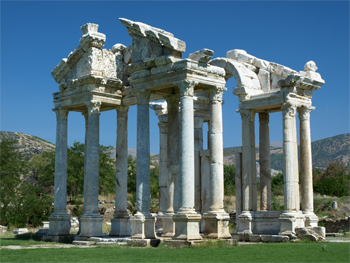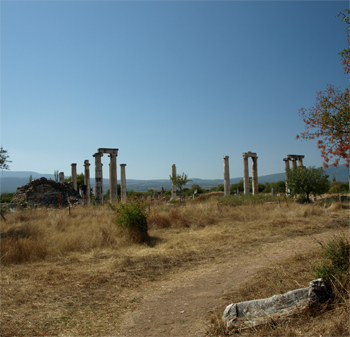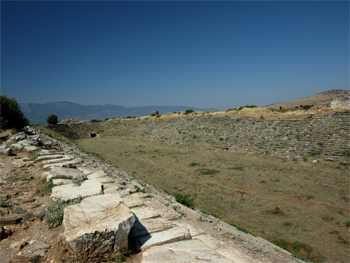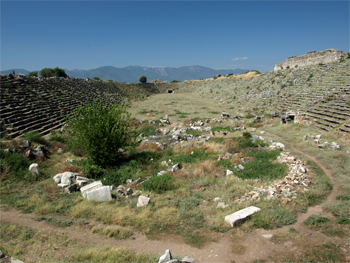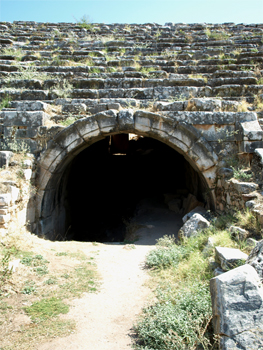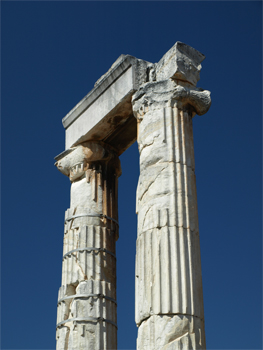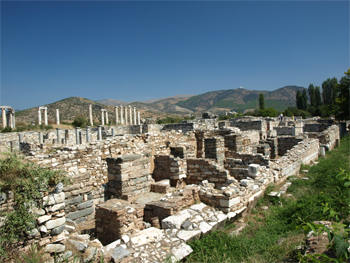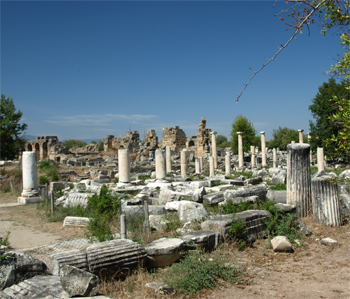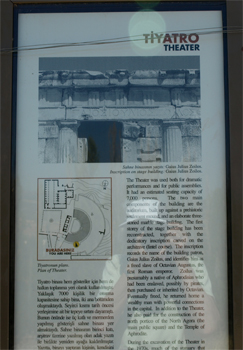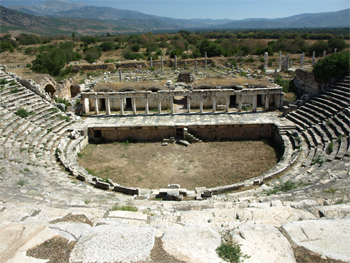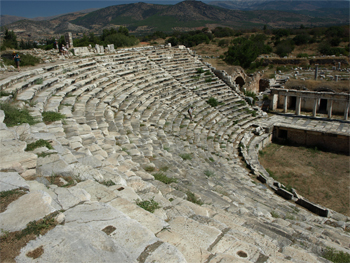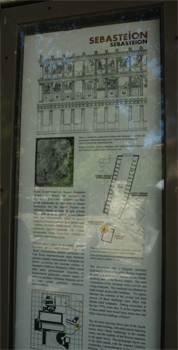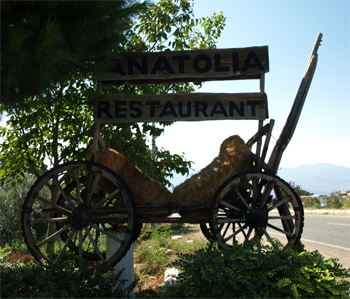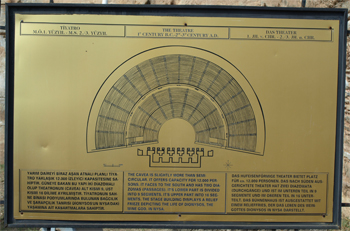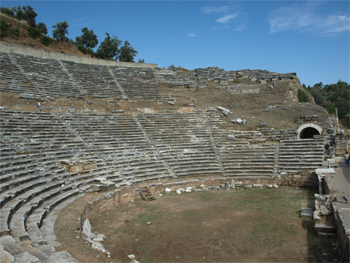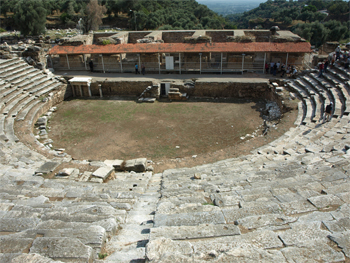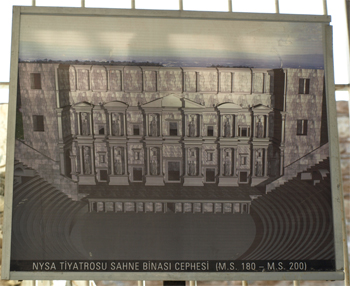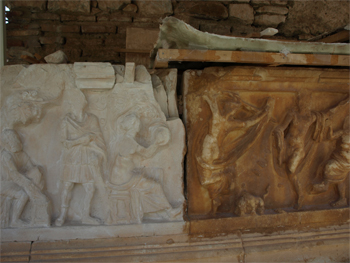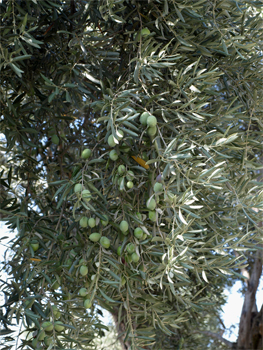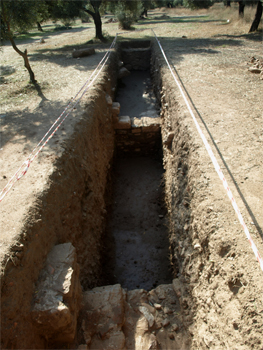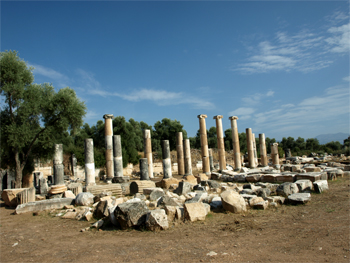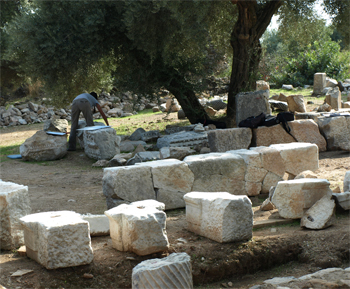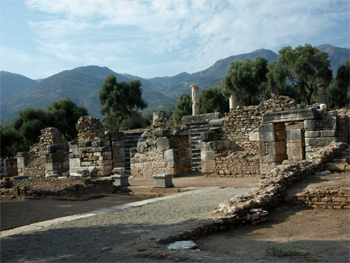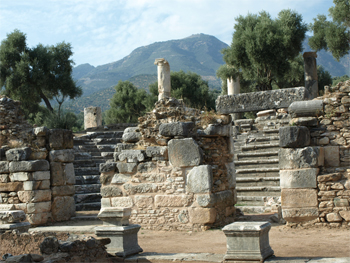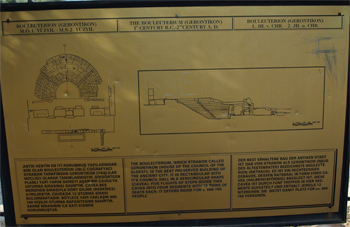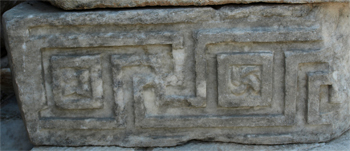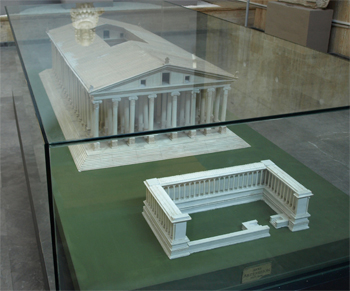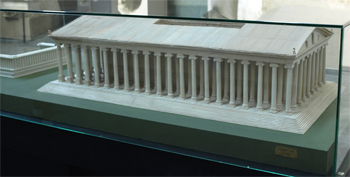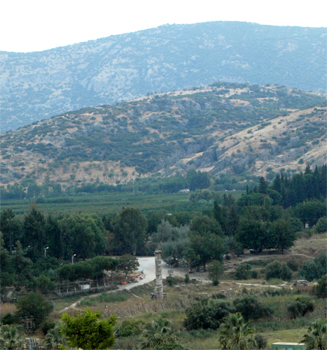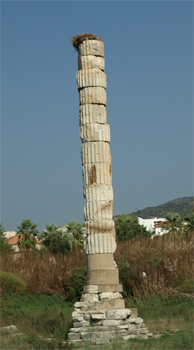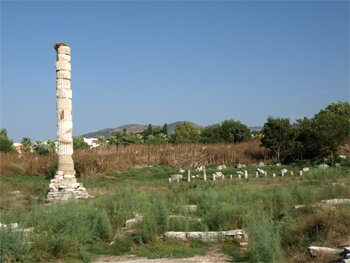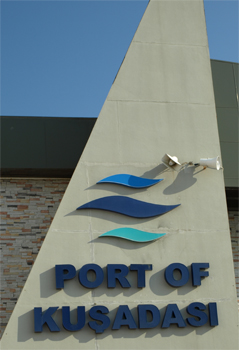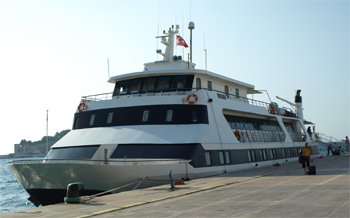At 8 AM we got on the bus for a 2 and ¾ hour ride (with one rest stop at a gas station) to Aphrodisias. It is an ancient Roman city (5th century BC) dedicated to Aphrodite, the goddess of love. In the 13th century AD it was abandoned and the city was buried by a series of earthquakes. We walked past a bunch of sarcophagi and burial urns unearthed at the site. The marble slabs were ornately carved. (Link to further information about Aphrodisias - use the back arrow key to return here.)
The museum building at the site contains wonderful Roman marble sculptures (bas relief, mostly) of gods and goddesses and scenes from mythology. They are very well preserved and show a lot of detail.
|
Map of the ruins
|
Sarcophagi
|
Burial urns |
Sarcophagus detail |
Cats, cats, and more cats everywhere and every time you stop
|
On our way to the hippodrome, we looked at the remains of the entrance to the pagan temple of Aphrodite. Only a few of the temple columns are standing. We needed lots of imagination to visualize the temple. |
Entrance gate, the Tetrapylon, to the Temple of Aphrodite with remaining columns of the temple in the background
|
Entrance gate, the Tetrapylon, to the Temple of Aphrodite
|
Entrance gate, the Tetrapylon, to the Temple of Aphrodite |
Temple of Aphrodite
|
The hippodrome seats were mostly uncovered but the floor of the structure remains under about eight feet of dirt. The hippodrome was used for chariot races and gladiator fights and is about a half a mile long and an eighth of a mile wide. Marge managed to get stung by a very aggressive bee at this location. Of course, the Benedryl was back at the hotel. |
Hippodrome
|
Hippodrome |
An entrance to the hippodrome - again we see an arch supporting the tiers of seats
|
There were good examples of how some of the columns were erected. Not all were a single piece of marble; many of them had three sections. A hole in the lower one received a node from the higher one. Lead was poured into the hole, the pieces put in place, and excess lead could flow out the groove.
|
Overview of ruins
|
Hadrian's Bath |
Overview of ruins - what a jigsaw puzzle!
|
Overview of ruins |
The Theater |
|
|
The Sebasteion - a temple dedicated to Aphrodite |
Grave of Kenan Erim, the archeologist most responsible for the excavation of Aphrodisias |
We ate lunch at the Anatolia Restaurant - a tourist restaurant with many tour buses beside ours. The meal was good - salad, pita, bread, kabob or kofte (meatballs) and fruit.
|
Next we drove to Nysa, which is an archeological site that few tourists visit. It has a well preserved Greek theater built into the side of the mountain. On the stage (added by the Romans) were more bas relief sculptures of Bacchus to whom the city was dedicated. (Link to further information about Nysa - use the back arrow key to return here.) The city was covered by a very productive olive grove. When the government claimed the land as an historical site, the farmers were allowed to continue growing and harvesting olives. The trees were full of green, unripe olives. This dig was begun in the 1960’s by a New York University professor and is continuing today. Some of the areas have revealed artifacts of earlier residents, dating back to 2800 to 2200 BC! It is incredible the way it seems that you could dig down eight to twelve feet almost anywhere in Turkey and uncover prior civilizations. Several columns are standing in the area of the agora or marketplace but much more work needs to be done. The Odeon (political theater) is well reconstructed.
|
|
Theater at Nysa |
Theater at Nysa
|
Stage of the Theater at Nysa |
Stage of the Theater at Nysa
|
Restored and unrestored reliefs from stage facade |
Olives
|
"Dig" area
|
Agora |
Archeologist at work
|
Entrance to Bouleuterion or Odeon |
Entrance to Bouleuterion
|
Bouleuterion |
Bouleuterion - has the same function as an odeion
|
Carved facade |
|
One of the carvings looks like a Greek key design but is really a depiction of the Meander River that flows (meanders) nearby. Meanders were among the most important symbols in ancient Greece. They perhaps symbolized infinity and unity; many ancient Greek temples incorporated the sign of the meander. Interspersed are river flowers, insects, and fish.
|
Dinner was a gluttonous buffet here at the Charisma Hotel. The dessert tables were to die for but so were the fifty or so starters plus soup and main courses. We sampled as much as we could eat. Marge ate almost her entire dinner from the dessert buffet! We hope our meals will be more sane in the next part of this tour, which will be on board the ship, Pegasus.
Thursday - 9/18 – Kusadasi – Ephesus - Pegasus
This morning we had a lecture on Ephesus and since we had already toured there, we could visualize what Murat was describing. Ephesus is a very old settlement and the ruins that are being reconstructed now are actually the third city at what was once a very commercial harbor at the end of several trade routes. According to legend, Androcles followed instructions from the Oracle of Delphi and settled the city where “a fish meets a wild boar.” The ancients landed here from Greece and were frying fish when one jumped out of the hot grease and set a bush on fire. That startled a boar which was resting beneath it.
Since there were many tourists (cruise ships were in port) at the entrance to Ephesus we went up the mountain to the House of the Virgin Mary first. It is believed that St John, the Friend, took care of Mary as requested by the dying Jesus and brought her to this area where St. John preached and wrote his “letters.” The house is in a beautiful setting and has a baptismal pool (with steps down into the stone lined pool), a place outdoors where mass is now heard (there are a few Irish Catholics in the area), and a stone house reconstructed on top of a first century AD foundation - supposedly where she lived. The house is a shrine now to the Virgin Mary. Walking through the house gave me goose bumps. (Link to further information about the House of the Virgin - use the back arrow key to return here.)
House of the Virgin Mary |
A Turkish mail box - of interest because it was there - we didn't see many anywhere else
|
We returned to the upper gate of Ephesus and repeated our earlier tour - link to Ephesus pictures - use your back arrow key to return here.
Next we had lunch at a tourist restaurant - very good Turkish food - and then went again to the small Ephesus Museum - link to Ephesus Museum pictures - use your back arrow key to return here.
We stopped to visit the one remaining (of 127 original) column of the Temple of Artemis, which was one of the seven wonders of the ancient world. Not much is left of the site. The marble was “recycled” into St. John’s basilica and the fort up on the hilltop. (Link to further information about the Temple of Artemis- use the back arrow key to return here.)
Model of the Temple of Artemis
|
Model of the Temple of Artemis |
View of the site of the Temple of Artemis from the tomb of St. John |
Remaining column from the Temple of Artemis
|
Remaining column from the Temple of Artemis and other fallen pieces |
We headed back to Kusadasi, said goodbye to Murat, and boarded our boat, the Pegasus, which will be our home for the next 7 nights.
|
Pegasus |
Once on board we met our guide for the Greek portion of this tour, George Terezakis, and got the good news that we have a nice relatively large cabin and the bad news that because of the gale force winds (Meltemi or Etesian winds) in the Aegean, we will not be visiting any of the Greek Isles we were supposed to see. Instead we stopped at the island of Samos to pick up our lecturer, Kathryn Dunathan (a Floridian who married a Greek farmer) and have our passports stamped by Greek customs for entry into the EU, etc. and then hightailed it north and west to the protected coast of the mainland and the Peloponnesian peninsula.
We ate dinner while docked in Samos (but were not allowed off the boat) and then sailed for 18 hours through very rough seas. I wore a Dramamine patch and took the seasick pills the ship was handing out like candy and still felt queasy. Marge even took a seasick pill! We had to stay lying down on our little beds to keep from getting hurt by trying to move around. It was quite a ride!!
| Continue to Greece | Return to Top | Return to Turkey Itinerary | Return to Dreamcatcher Home Page |
